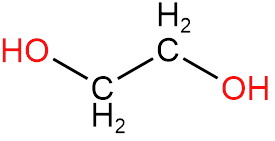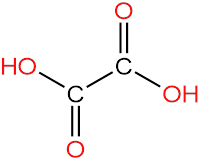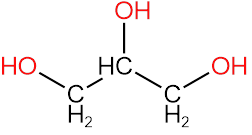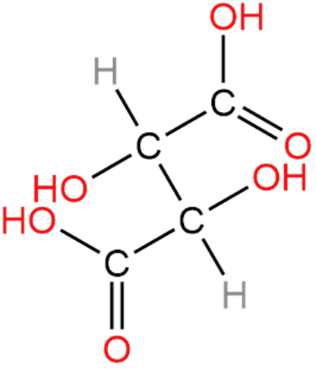
Which of the following is optically active
A. Ethylene glycol
B. Oxalic acid
C. Glycerol
D. Tartaric acid
Answer
219.3k+ views
Hint: The compound which rotates the plane polarised light in a clockwise or in an anticlockwise direction is called an optically active compound. For a compound to be optically active it must contain at least one chiral carbon.
Complete answer:The optical activity of any compound can be determined by passing the plane-polarised light through the compound, if the compound rotates the plane-polarised light in a clockwise direction it is called dextrorotatory and if the compound rotates the plane-polarised light in an anti-clockwise direction it is called levorotatory. For a compound to be optically active compound must contain a chiral carbon or a chiral center, a chiral carbon is a carbon that is attached to four different substituents and a chiral center is a stereogenic center containing four different substituents.
The structures of the given compounds are –
1. Ethylene glycol

In ethylene glycol, we can see that there is no chiral carbon because with both the carbons two hydrogens are attached.
2. Oxalic Acid

In oxalic acid, we can see that there is no chiral carbon because oxygen is attached with a double bond with both carbons.
3. Glycerol

In glycerol as well there is no chiral carbon because CH2OH is a common substituent attached to the center carbon.
4. Tartaric Acid

In tartaric acid, we can see that there are two chiral carbons so tartaric acid is optically active.
Thus, Option (D) is correct
Note: Tartaric acid have three optical isomerism. D- tartaric acid, l- tartaric acid and meso- tartaric acid. Among these three isomers D- tartaric acid and l- tartaric acid are optically active and meso- tartaric acid is optically inactive.
Complete answer:The optical activity of any compound can be determined by passing the plane-polarised light through the compound, if the compound rotates the plane-polarised light in a clockwise direction it is called dextrorotatory and if the compound rotates the plane-polarised light in an anti-clockwise direction it is called levorotatory. For a compound to be optically active compound must contain a chiral carbon or a chiral center, a chiral carbon is a carbon that is attached to four different substituents and a chiral center is a stereogenic center containing four different substituents.
The structures of the given compounds are –
1. Ethylene glycol

In ethylene glycol, we can see that there is no chiral carbon because with both the carbons two hydrogens are attached.
2. Oxalic Acid

In oxalic acid, we can see that there is no chiral carbon because oxygen is attached with a double bond with both carbons.
3. Glycerol

In glycerol as well there is no chiral carbon because CH2OH is a common substituent attached to the center carbon.
4. Tartaric Acid

In tartaric acid, we can see that there are two chiral carbons so tartaric acid is optically active.
Thus, Option (D) is correct
Note: Tartaric acid have three optical isomerism. D- tartaric acid, l- tartaric acid and meso- tartaric acid. Among these three isomers D- tartaric acid and l- tartaric acid are optically active and meso- tartaric acid is optically inactive.
Recently Updated Pages
Is PPh3 a strong ligand class 12 chemistry JEE_Main

Full name of DDT is A 111trichloro22bispchlorophenyl class 12 chemistry JEE_Main

Sodium acetate on heating with soda lime produce A class 12 chemistry JEE_Main

Find the isoelectric point pI of Lysine A 556 B 974 class 12 chemistry JEE_Main

The order of basicity among the following compounds class 12 chemistry JEE_Main

The number of isomers in C4H10O are a7 b8 c6 d5 class 12 chemistry JEE_Main

Trending doubts
JEE Main 2026: Application Form Open, Exam Dates, Syllabus, Eligibility & Question Papers

Derivation of Equation of Trajectory Explained for Students

Hybridisation in Chemistry – Concept, Types & Applications

Understanding the Angle of Deviation in a Prism

Understanding Collisions: Types and Examples for Students

Understanding Atomic Structure for Beginners

Other Pages
NCERT Solutions For Class 12 Chemistry Chapter 1 Solutions - 2025-26

NCERT Solutions for Class 12 Chemistry Chapter Chapter 7 Alcohol Phenol and Ether

NCERT Solutions ForClass 12 Chemistry Chapter Chapter 8 Aldehydes Ketones And Carboxylic Acids

JEE Advanced Marks vs Ranks 2025: Understanding Category-wise Qualifying Marks and Previous Year Cut-offs

Haloalkanes and Haloarenes Class 12 Chemistry Chapter 6 CBSE Notes - 2025-26

Solutions Class 12 Chemistry Chapter 1 CBSE Notes - 2025-26




